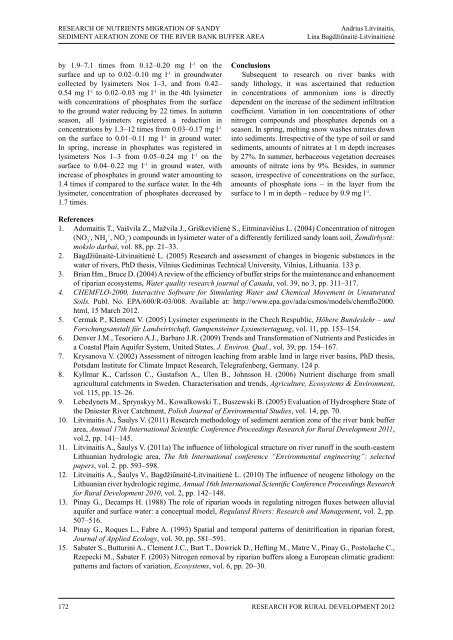RESEARCH FOR
RESEARCH FOR
RESEARCH FOR
You also want an ePaper? Increase the reach of your titles
YUMPU automatically turns print PDFs into web optimized ePapers that Google loves.
<strong>RESEARCH</strong> OF NUTRIENTS MIGRATION OF SANDY<br />
SEDIMENT AERATION ZONE OF THE RIVER BANK BUFFER AREA<br />
by 1.9–7.1 times from 0.12–0.20 mg l -1 on the<br />
surface and up to 0.02–0.10 mg l -1 in groundwater<br />
collected by lysimeters Nos 1–3, and from 0.42–<br />
0.54 mg l -1 to 0.02–0.03 mg l -1 in the 4th lysimeter<br />
with concentrations of phosphates from the surface<br />
to the ground water reducing by 22 times. In autumn<br />
season, all lysimeters registered a reduction in<br />
concentrations by 1.3–12 times from 0.03–0.17 mg l -1<br />
on the surface to 0.01–0.11 mg l -1 in ground water.<br />
In spring, increase in phosphates was registered in<br />
lysimeters Nos 1–3 from 0.05–0.24 mg l -1 on the<br />
surface to 0.04–0.22 mg l -1 in ground water, with<br />
increase of phosphates in ground water amounting to<br />
1.4 times if compared to the surface water. In the 4th<br />
lysimeter, concentration of phosphates decreased by<br />
1.7 times.<br />
Andrius Litvinaitis,<br />
Lina Bagdžiūnaitė-Litvinaitienė<br />
conclusions<br />
Subsequent to research on river banks with<br />
sandy lithology, it was ascertained that reduction<br />
in concentrations of ammonium ions is directly<br />
dependent on the increase of the sediment infiltration<br />
coefficient. Variation in ion concentrations of other<br />
nitrogen compounds and phosphates depends on a<br />
season. In spring, melting snow washes nitrates down<br />
into sediments. Irrespective of the type of soil or sand<br />
sediments, amounts of nitrates at 1 m depth increases<br />
by 27%. In summer, herbaceous vegetation decreases<br />
amounts of nitrate ions by 9%. Besides, in summer<br />
season, irrespective of concentrations on the surface,<br />
amounts of phosphate ions – in the layer from the<br />
surface to 1 m in depth – reduce by 0.9 mg l -1 .<br />
references<br />
1. Adomaitis T., Vaišvila Z., Mažvila J., Griškevičienė S., Eitminavičius L. (2004) Concentration of nitrogen<br />
- + - (NO , NH4 , NO2 ) compounds in lysimeter water of a differently fertilized sandy loam soil, Žemdirbystė:<br />
3<br />
mokslo darbai, vol. 88, pp. 21–33.<br />
2. Bagdžiūnaitė-Litvinaitienė L. (2005) Research and assessment of changes in biogenic substances in the<br />
water of rivers, PhD thesis, Vilnius Gediminas Technical University, Vilnius, Lithuania. 133 p.<br />
3. Brian Hm., Bruce D. (2004) A review of the efficiency of buffer strips for the maintenance and enhancement<br />
of riparian ecosystems, Water quality research journal of Canada, vol. 39, no 3, pp. 311–317.<br />
4. CHEMFLO-2000, Interactive Software for Simulating Water and Chemical Movement in Unsaturated<br />
Soils. Publ. No. EPA/600/R-03/008. Available at: http://www.epa.gov/ada/csmos/models/chemflo2000.<br />
html, 15 March 2012.<br />
5. Cermak P., Klement V. (2005) Lysimeter experiments in the Chech Respublic, Höhere Bundeslehr – und<br />
Forschungsanstalt für Landwirtschaft, Gumpensteiner Lysimetertagung, vol. 11, pp. 153–154.<br />
6. Denver J.M., Tesoriero A.J., Barbaro J.R. (2009) Trends and Transformation of Nutrients and Pesticides in<br />
a Coastal Plain Aquifer System, United States, J. Environ. Qual., vol. 39, pp. 154–167.<br />
7. Krysanova V. (2002) Assessment of nitrogen leaching from arable land in large river basins, PhD thesis,<br />
Potsdam Institute for Climate Impact Research, Telegrafenberg, Germany. 124 p.<br />
8. Kyllmar K., Carlsson C., Gustafson A., Ulen B., Johnsson H. (2006) Nutrient discharge from small<br />
agricultural catchments in Sweden. Characterisation and trends, Agriculture, Ecosystems & Environment,<br />
vol. 115, pp. 15–26.<br />
9. Lebedynets M., Sprynskyy M., Kowalkowski T., Buszewski B. (2005) Evaluation of Hydrosphere State of<br />
the Dniester River Catchment, Polish Journal of Environmental Studies, vol. 14, pp. 70.<br />
10. Litvinaitis A., Šaulys V. (2011) Research methodology of sediment aeration zone of the river bank buffer<br />
area, Annual 17th International Scientific Conference Proceedings Research for Rural Development 2011,<br />
vol.2, pp. 141–145.<br />
11. Litvinaitis A., Šaulys V. (2011a) The influence of lithological structure on river runoff in the south-eastern<br />
Lithuanian hydrologic area, The 8th International conference “Environmental engineering”: selected<br />
papers, vol. 2. pp. 593–598.<br />
12. Litvinaitis A., Šaulys V., Bagdžiūnaitė-Litvinaitienė L. (2010) The influence of neogene lithology on the<br />
Lithuanian river hydrologic regime, Annual 16th International Scientific Conference Proceedings Research<br />
for Rural Development 2010, vol. 2, pp. 142–148.<br />
13. Pinay G., Decamps H. (1988) The role of riparian woods in regulating nitrogen fluxes between alluvial<br />
aquifer and surface water: a conceptual model, Regulated Rivers: Research and Management, vol. 2, pp.<br />
507–516.<br />
14. Pinay G., Roques L., Fabre A. (1993) Spatial and temporal patterns of denitrification in riparian forest,<br />
Journal of Applied Ecology, vol. 30, pp. 581–591.<br />
15. Sabater S., Butturini A., Clement J.C., Burt T., Dowrick D., Hefting M., Matre V., Pinay G., Postolache C.,<br />
Rzepecki M., Sabater F. (2003) Nitrogen removal by riparian buffers along a European climatic gradient:<br />
patterns and factors of variation, Ecosystems, vol. 6, pp. 20–30.<br />
172 ReseaRch foR RuRal Development 2012


